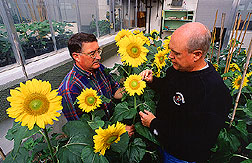Mid-Oleic Sunflower Hybrids Debut
|
|
New sunflower hybrids have been genetically revamped to produce a healthful vegetable oil that's so much better for deep fat frying that domestic and export markets may quickly grow.
"By the year 2001, U.S. acreage of oilseed sunflowers could well double from its present 2.2 million," predicts Larry Kleingartner, executive director of the National Sunflower Association (NSA).
Oils derived from the new hybrids have just the right composition to make fried foods taste better and stay fresh longer than foods prepared in oils from traditional sunflower hybrids, Agricultural Research Service scientists have found.
The new hybrids, collectively called NuSun, produce oil that's several times higher in oleic acid than traditional sunflower oil. And it holds up longer in frying vats--even without being hydrogenated.
NuSun oil's bright promise is recognized by a mid-oleic task force organized by the NSA, which has been promoting commercialization. The task force includes researchers, growers, and people in the seed, vegetable oil processing, and food industries. NuSun hybrids are being grown on some 100,000 acres this year.
In the United States, oilseed sunflowers are grown mostly in the Northern and Central Great Plains. The crop produces about 440,000 tons of vegetable oil, about 70 percent of which is exported.
ARS geneticist Jerry F. Miller and biochemist Brady A. Vick at Fargo, North Dakota, found that a single, dominant gene ensures any number of sunflower hybrids can be easily bred to produce oil that's in the mid-oleic range 60 to 75 percent oleic acid. In 2 years of tests, this range remained stable in different growing environments from North Dakota to Kansas.
Oleic acid is termed a monounsaturated fatty acid. Some studies have indicated that a high proportion of fat as oleic acid in moderately low-fat diets can lower serum cholesterol and the risk of coronary heart disease.
Another nutritional asset, a rich vitamin E content already in traditional sunflower hybrids, remains just as abundant in NuSun hybrids, according to ARS tests in 1997.
So far, Miller and Vick have found that, through conventional breeding, NuSun hybrids can be developed to produce oil with nearly 30 percent less saturated fatty acids than traditional hybrids. Potato chips fried in such oil could be labeled as "Low in Saturated Fat," having less than 1 gram of saturated fat per 28.4-gram (1-ounce) serving.
To reduce saturated fat even further, the Fargo scientists have produced some plants with mutations for low levels of palmitic acid and others with low stearic acid levels. By crossing both of these mutant types with established breeding lines, they have produced oil with a palmitic-stearic range of 6 to 9 percent, in contrast to 11 to 12 percent in traditional hybrids.
"NuSun could become an exciting new venture in the oilseed sunflower industry," says Curt Stern, field operations manager for the sunflower division of Archer Daniels Midland Company at Enderlin, North Dakota.
"If the entire U.S. snack food industry switches to NuSun oil, it will need roughly 4 billion pounds a year--about 4 million acres of cropland. And because mid-oleic oil requires no hydrogenation and is low in saturated fats, fast foods and salad oils may also become large markets," says Stern.
High-oleic sunflower oil has been a specialty oil since 1988. However, the food industry mainly uses less expensive oils, like cottonseed and partially hydrogenated soybean oil.
There's Lots To Recommend Them
Many seed companies have developed NuSun hybrids using genetic resources released by ARS. These hybrids may provide a reliable supply of mid-oleic NuSun oil to food industries, says Miller.
"In field tests, we've shown that commercial NuSun and our experimental hybrids are as good as traditional sunflowers in economic qualities such as yield potential."
By switching hybrids, farmers may see steadily increasing demand for their crop at home and abroad. And if NuSun is successful, NSA's Kleingartner says, each segment of the market chain should benefit. Among the big winners: Health- and cost-conscious consumers and vegetable oil processors.
The costly processing step of bubbling hydrogen into polyunsaturated oils--partial hydrogenation--won't be required to protect against flavor deterioration. No hydrogenation means no formation of trans fatty acids that some nutritionists claim may be unhealthful. Not common in plants, trans fatty acids are geometrically altered forms of once polyunsaturated fatty acids, like linoleic and linolenic, that had multiple places for hydrogen atoms to bond, or saturate.
A commercial NuSun hybrid making its debut this year produces oil that's about 65 percent oleic acid. The 69 percent linoleic acid content of traditional sunflower oil was reduced to 26 percent, which means the new oil doesn't have to be hydrogenated.
Linoleic acid is a key to giving fried foods their flavor. But even with less linoleic acid, there's still enough for desired flavor in fried foods, according to sensory panel evaluations at the ARS National Center
for Agricultural Utilization Research (NCAUR), Peoria, Illinois.
"Tortilla chips fried in NuSun oil have a high intensity of fried-food flavor," says NCAUR food technologist Kathleen Warner. With aging, the NuSun chips stay fresh-tasting longer than chips fried in commercial sunflower oil.
Snack food companies could benefit as consumers become repeat buyers of flavor-stable chips, Warner says. The companies could benefit further by not needing to replace used NuSun oils as frequently as they might more polyunsaturated frying oils. However, no simple test yet exists to precisely compare the fry life of vegetable oils or to know when one should be changed.
Many different compounds are formed when vegetable oils are heated, explains Warner. Research at NCAUR on measuring these compounds is a step toward learning their effects on flavor and could eventually lead to benchmarks for determining when to replace oil in a deep fryer.
Moreover, at frying temperatures, NuSun oil produces lower intensities of off-odors. Sunflower oil, until now, has often been blended with cottonseed oil to ensure a pleasing fried-food aroma.--By Ben Hardin, Agricultural Research Service Information Staff.
Jerry F. Miller and Brady A. Vick are at the USDA-ARS Red River Valley Agricultural Research Center, P.O. Box 5677, University Station, Fargo, ND 58105; phone (701) 239-1321, fax (701) 239-1346.
Kathleen A. Warner is at the USDA-ARS National Center for Agricultural Utilization Research, 1815 N. University St., Peoria, IL 61604; phone (309) 681-6555, fax (309) 681-6679.
"Mid-Oleic Sunflower Hybrids Debut" was published in the June 1998 issue of Agricultural Research magazine. Click here to see this issue's table of contents








